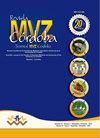Asociación del polimorfismo FecB con la prolificidad natural del Ovino de Pelo Colombiano
IF 0.3
4区 农林科学
Q4 AGRICULTURE, DAIRY & ANIMAL SCIENCE
引用次数: 4
Abstract
Objective. Characterize and associate the FecB polymorphism with the natural prolificacy in the biotypes of Colombian Creole Sheep (OPC) Etiope and Sudan. Materials and methods. At 300 births from 167 OPC sheep, from the biotypes, Sudan (n = 73) and Etiope (n = 94), the effect of the FecB genotype was measured, and of the non-genetic factors: number of parturitions of the mother, the father, the season and the year of conception. For this, the animals were genotyped by PCR-RFLP (AvaII) for FecB and the productive records of the herd analyzed. The allelic and genotypic frequencies were calculated, which, together with the non-genetic factors, were associated with litter size using a fixed-effect GLM model. Results. The FecBB allele presented lower frequency (0.379±0.152) than the FecB+ allele (0.622±0.152) for the whole OPC. These frequencies varied (p<0.05) between biotypes (Sudan: 0.486, Etiope: 0.271), the same occurred with the FecBBB genotype (0.078 in Etiope and 0.236 in Sudan). The FecB++ genotype was more frequent in Etiope (0.526) and the heterozygous genotype in Sudan (0.5) and for the OPC (0.448±0.070). No significant differences were found between biotypes for non-genetic factors. The prolificacy varied (p<0.05) between biotypes (1.45±0.22 in Etiope and 1.34±0.03 in Sudan), with an average of 1.40±0.11 for the OPC. Conclusions. The lucus studied was polymorphic. The litter size was not affected by non-genetic factors or the FecB genotype. These results can be used in assisted selection plans to increase OPC productivity. .FeCB多态性与哥伦比亚毛羊自然繁殖力的关系
客观的在哥伦比亚克里奥尔绵羊(OPC)Etiope和苏丹的生物型中,表征FecB多态性并将其与自然多产性联系起来。材料和方法。在167只OPC绵羊的300只出生时,测量了FecB基因型和非遗传因素的影响:母亲的分娩次数、父亲、受孕季节和年份。为此,通过PCR-RFLP(AvaII)对动物进行FecB基因分型,并分析牛群的生产记录。使用固定效应GLM模型计算等位基因和基因型频率,这些频率与非遗传因素一起与产仔数相关。后果在整个OPC中,FecBB等位基因的频率(0.379±0.152)低于FecB+等位基因(0.622±0.152。这些频率在生物型之间变化(p<0.05)(苏丹:0.486,表位:0.271),FecBBB基因型也发生了变化(表位0.078,苏丹0.236)。FecB++基因型在Etiope(0.526)更常见,杂合基因型在苏丹(0.5)和OPC(0.448±0.070)更常见。在非遗传因素的生物型之间没有发现显著差异。不同生物型的繁殖力不同(p<0.05)(Etiope为1.45±0.22,苏丹为1.34±0.03),OPC的平均繁殖力为1.40±0.11。结论。研究的苜蓿是多态性的。产仔数不受非遗传因素或FecB基因型的影响。这些结果可用于辅助选择计划,以提高OPC生产率。
本文章由计算机程序翻译,如有差异,请以英文原文为准。
求助全文
约1分钟内获得全文
求助全文
来源期刊

Revista Mvz Cordoba
农林科学-奶制品与动物科学
CiteScore
0.70
自引率
0.00%
发文量
41
审稿时长
6-12 weeks
期刊介绍:
The Journal MVZ Córdoba is an open access international scientific journal financed and edited by the University of Córdoba (Colombia). The journal publishes quarterly, continuously in PDF, XML, Epub, original articles, literature reviews, brief communications and clinical cases, peer-reviewed (double-blind) in Spanish and English, which are related to the agricultural and veterinary sciences. The journal is directed to natural and legal persons of veterinary medicine, animal husbandry, public health, epidemiology, aquaculture, biology, basic biomedical sciences and biotechnology and constitutes a space for academic and scientific discussion around the work of professionals in Veterinary Medicine and Zootechnics. Four-monthly publication.
"The Journal MVZ Córdoba supports the policies for registration of clinical trials of the World Health Organization (WHO) and the International Committee of Medical Journal Editors (ICMJE), since it recognizes the importance of these initiatives for international registration and dissemination. of information about clinical studies, in open access. As a result, since 2007, the journal MVZ Córdoba only publishes clinical research articles that have received an identification number in one of the Clinical Trial Registries validated by the criteria established by WHO and ICMJE, whose addresses are available in the ICMJE website. The identification number is recorded at the end of the summary. "
 求助内容:
求助内容: 应助结果提醒方式:
应助结果提醒方式:


